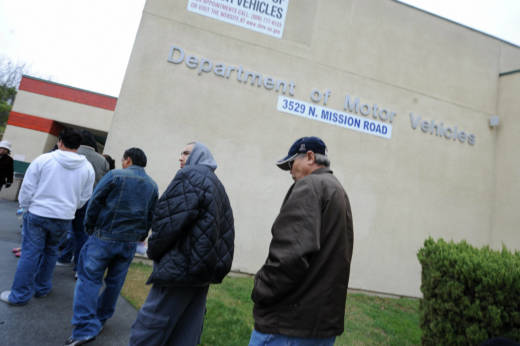


The worst story came from Susan Valot, a freelance reporter who lives in Southern California. For the record, she knows you can make appointments online in advance. But like so many of us, she was too late getting her act together.
“I had to put myself at the mercy of the DMV because my driver’s license expired,” Valot says.
This was last fall, before the rollout of the Real ID, a driver’s license that can be used to board domestic flights starting in October 2020. The Real ID requires an in-person visit, and it’s the foremost reason for the current surge in wait times.
Even back then, Valot researched to find out which local DMV had the shortest lines, on what days and at what times. She waited only an hour to get a temporary license at the field office in San Pedro, not including the time it took her to park. Then, she waited for her permanent license to come in the mail, but weeks passed and the temporary license approached its expiration date.
Finally, she called and talked to a sympathetic customer service representative, who informed Valot the system had no record of her application for a license, “and if you’re caught driving with an expired license, they might take your car away.”
Valot was dismayed, mortified and incensed.
“But I have the temporary license. I can prove that I applied for a license.” she told the man.
He replied, “I believe you, but nothing ever came through on our system. You have to go back down to the DMV and have them fix it.”
The second trip to the San Pedro DMV took twice as long, and there again, the customer service representative was sympathetic. Valot said the woman told her: “There’s some kind of glitch in the system, and it doesn’t go through to the state, and the state knew about it.” The woman, whom Valot described as frustrated because it hadn’t been fixed, added, “Believe me, you’re not the first person this has happened to.”
Of course, if Valot now wants to get a driver’s license that’s a Real ID, she’d have to go back a third time.
“I have my passport, so I’m not going to put myself through that hell,” she says.
The hacker’s perspective
I asked Michelle Thong, co-founder of Code for San Jose, to join me at a local DMV. The group is one of more than 70 Code for America chapters around the country made up of techies keen to volunteer their skills for the civic good.
“Many engineers and designers get a lot of satisfaction working on problems that make people’s lives better,” Thong says, explaining that civic hacking is more collaborative or complementary than confrontational. For example, she proudly points to a local renters’ rights website that Code for San Jose built recently: Rentersrightsguide.org.
It’s been years since Thong herself went to a DMV field office. She’s had success with the DMV website. So we take a moment to observe the system most large field offices use.
There are actually two lines in operation. The first: to get in the door and have somebody confirm you have the proper paperwork to get your need met. The second: to get a number so you can wait to be called to a desk. Both of these waits can last hours.
Surely, I ask her, there’s a more efficient way to process all these people. Thong takes a moment. Her assessment seems obvious, once she says it: Figure out who, exactly, is in that first line, so it can be shrunk.
“If it turns out a lot of people are coming in person when they don’t need to, then maybe it’s more of an educational campaign to catch people before they come in and add to the wait times for everyone else who really needs to be here,” Thong opines.
The DMV has an action plan
Perhaps not surprisingly, given the demand for testimony at the state Capitol, the DMV has just announced plans to reduce the number of reasons you have to come to a field office in person — like say, getting a duplicate driver’s license. Also, while there are a number of places you can go to use DMV Now self-service terminals to get your registration renewed, DMV spokeswoman Jessica Gonzalez says there will be more coming soon.
“We’re putting those into 10 additional field offices this month. We currently have them in 60 field offices. Later this year, we’re going to expand to 50 additional grocery stores. We’re already in 40 retail locations, so this’ll bring our total to 160 statewide,” Gonzalez says.
She adds there will be more self-service check-in kiosks, too, at field offices, “If you know that you have everything you need and you’re ready, you can head on over to that free-standing kiosk and check in and get your service number right then and there.”
The DMV’s answer for the second line: text notifications “about 30 minutes or so before your number’s going to be called,” Gonzalez says. “So that way, you can go to the store, or do something else other than stand there and wait.”
This might kill what appears to be a new line of business for a California startup called YoGov that offers “live waiting concierge service,” as well as automated support booking a field office appointment online. The company has gotten a fair bit of media attention in recent months, but it is not working with the DMV’s cooperation or approval. Gonzalez says the agency is “investigating” YoGov, though she would not provide more details.
The agency recently opened 60 field offices on Saturday for a half-day. Now it promises to shift nearly 300 employees from DMV headquarters and other state agencies to field offices to help triage the longer lines.




